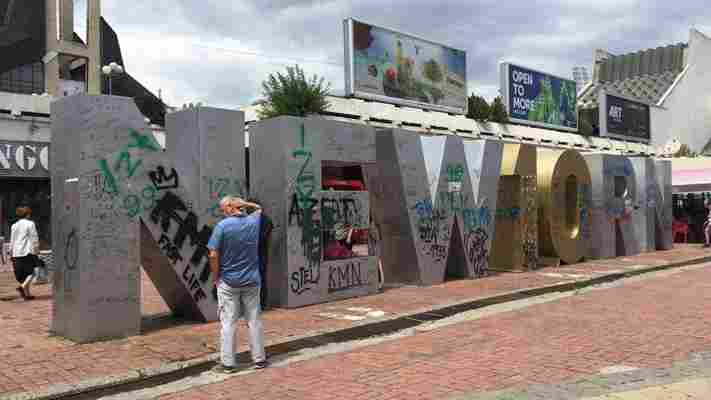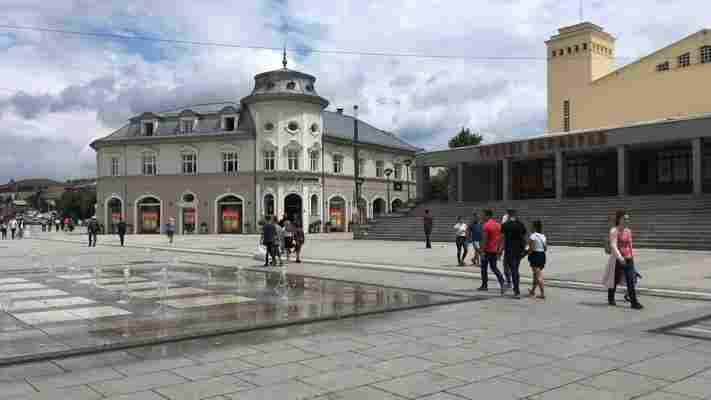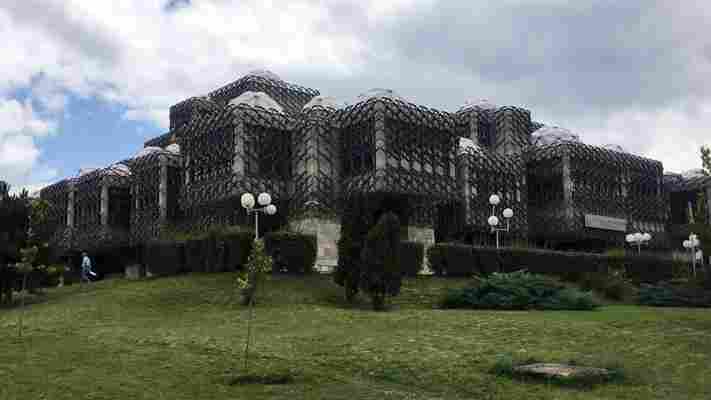Pristina, Kosovo, has the distinction of often being dismissed as one of Europe’s ugliest capitals. It’s certainly a place I never thought I’d visit. My only reference point of the place was from some dark, distant corner of my mind, remembering tragic news coverage of the Kosovo War in the late 1990s after years of ethnic cleansing that displaced some 750,000 ethnic Albanians . For years, Kosovo’s ethnic Albanian majority had vied for control of the region against Serbs, who, despite only making up 10% of the population, viewed Kosovo as the cradle of their cultural identity.

Kosovars declared their independence from Serbia in February 2008. Ten years later, I suddenly found myself in this mishmash of a city. Look one way, and minarets of centuries-old mosques reach towards the heavens and newly commissioned statues of domestic and foreign heroes stand tall. Look another way, and once-prestigious landmarks like the state-owned Grand Hotel now sit largely vacant with broken windows. “I don’t think it is the worst hotel in the world,” Kosovo’s president, Hashim Thaçi, said to a reporter from The New York Times . “But that is because the world is very big.”

Pristina, Kosovo, is often dismissed as Europe’s ugliest capital city (Credit: Deborah Huso)
Yet here I was on a warm summer evening, picking my way along a back alley several blocks south of the Cathedral of St Mother Teresa near Bill Clinton and George Bush boulevards. I’d only come to Pristina to pass through on my way out of the Balkans after a 10-day hike in the Albanian Alps. After checking into a rental flat with no running water (a neighbourhood-wide issue that my host could not explain), I set out on my own, determined to make the most of my short two-day stay.
You may also be interested in: • The country with a new (old) name • ‘I’m from a country that no longer exists’ • The tiny ‘nation’ you’ve never heard of
With its square-ish concrete, Communist-style buildings and dusty streets, it quickly became apparent why Pristina gets a bad rap. Lonely Planet called it “not the most aesthetically pleasing city you’ll ever come across,” and The Boston Globe once said, “This Balkan city is perhaps the ugliest and most fun capital in in Europe.” But given its recent bloody and politically tumultuous past, comparing Pristina to a place like Paris or Rome isn’t exactly fair. After all, in the last century alone, warfare in the Balkans has led Kosovo to be ruled by the Ottoman Empire, the kingdom of Serbia, Yugoslavia, even Italy (as part of Greater Albania during World War Two) and Serbia again.
Today, despite boasting some of the oldest mosques in Europe, much of Pristina’s once-proud Ottoman architecture has been replaced by communist structures from its Yugoslavian days. In fact, my one goal while in town was to see the most notorious of these communist-era constructions: the National Library of Kosovo , a massive jumble of concrete blocks that has been called one of the world’s ugliest buildings by Virtual Tourist. Opened in 1982, the National Library is Pristina’s most striking work of architecture: a Brutalist behemoth whose fence-like metal exterior is suggestive of a jail.
However, as I pushed through the glass doors hidden beneath the library’s metal facade, I found that there is a distinctive beauty in this building, with its 99 domes and large windows. Both its unusual exterior and main hall’s mosaic marble stone floor, bathed in a wide swath of natural light from the building’s largest dome, suggest a link to Pristina’s lost Byzantine and Islamic architecture.

With its Brutalist architecture, the National Library of Kosovo has been called one of the ugliest buildings in the world (Credit: Deborah Huso)
But then, mere blocks away, is the fresh white spire of the Cathedral of St Mother Teresa, completed in 2017, 14 years after Pope John Paul II beatified its ethnic Albanian namesake. The soaring 76m structure is an ironic site here – both because Vatican City does not recognise Kosovo’s sovereignty and because 90% of Kosovo’s population is Muslim.
There is some poetic justice. Before the Ottoman Empire assumed a centuries-long rule of Kosovo beginning in the 14th Century, most Albanians were Christian. With Turkish rule, the majority converted to Islam to escape taxes levied on Christian subjects. My city guide Bekim Xhemili, curator and ethnologist at the Ethnological Museum of Kosovo , told me that today only 3% of Kosovars are Catholic.
The history of the Cathedral of St Mother Teresa’s construction reflects the desire of Kosovars to put decades of conflict (most of it ethnic rather than religious) behind them. According to Xhemili, Muslims as well as Christians donated funds to the cathedral’s construction, with many of those funds coming from ethnic Albanians living in the United States.
Completed in 2017, Pristina’s Cathedral of St Mother Teresa was paid for by donations from both Christians and Muslims (Credit: Greg Balfour Evans/Alamy)
But Kosovo’s path to peace and independence has not necessarily led to prosperity. Today, only 114 of the world’s 193 United Nations members recognise Kosovo’s sovereignty, and as Xhemili was quick to point out, much of its economy is supported by money coming in from relatives working in Western Europe. “Without all the money entering Kosovo from outside,” he said, “the economy would fail.” According to Kosovo Central Bank, Kosovars working abroad sent home some 752 million euros in 2015 alone. At the start of 2018, Kosovo’s unemployment rate stood at roughly 27% , and workforce participation by working-age Kosovars (ages 15-64) was a staggeringly low 39%.
You wouldn’t know things were so dire wandering Pristina’s streets, particularly its main pedestrian drag, Bulevardi Nënë Tereza. Filled with cafes and lined with everything from a concrete Spomenik memorial in remembrance of Yugoslavia’s liberation during World War Two to bronze figures painted with US and British flags, the street seemed to be bustling every hour of the day. Parents pushed prams, tourists licked cones of gelato and students rambled from one coffee shop to the next.
In fact, one of the most wonderful things I found about Pristina was its cafe culture. Walk a block or two, and you’ll encounter at least half a dozen cafes, and according to the Gastronomic Society of Pristina, there are more than 100 in a city of just 200,000 people. Like Pristina itself, its cafes reflect a blend of Balkan, European and Middle Eastern influences, with some pouring macchiatos so delicious they’d rival any in Italy, and others specialising in sweet-and-savoury Turkish brews.
Coffee aside, what makes these cafes unique is what they mean to the people who call this tiny landlocked place home. Cafes are a natural entrepreneurial endeavour in an area with few economic prospects – most everyone drinks coffee. They are also a gathering place for government workers, those without employment and young intellectuals. After all, it was in Kosovo’s cafes where the initial planning of its independence movement reportedly began.
According to the Gastronomic Society of Pristina, there are more than 100 cafes in a city of just 200,000 people (Credit: dpa picture alliance/Alamy)
A five-minute walk from the bustling Bulevardi Nënë Tereza, I came across the NEWBORN monument that celebrates Kosovo’s 11-year independence from Serbia. Every year on their independence day (17 February), Kosovars redecorate the monument with a new look. Some years, its giant letters are tagged with colourful graffiti. Other times, they’re covered with citizens’ signatures. According to an exhibit at the Kosovo Museum , this annual change reflects Kosovo’s ever-evolving quest for identity and symbolises its growth – whether sporting barbed wire to emulate breaking free from the past or featuring the flags of the nations that have recognised Kosovo’s sovereignty.
Across the street from NEWBORN, I spotted the more tragic Heroinat Memorial , unveiled in 2015 to honour the 20,000 women raped during the Kosovo War of 1998-99. Each pin of the monument represents one of the women, and, resting at different heights, they together reveal the contoured relief of a woman’s face. The monument was especially poignant for me. In the days before arriving in Pristina, I stayed in the homes of ethnic Albanians in Kosovo where I often sat for Turkish coffee with matriarchs who would begin to tell me hushed references about what happened to their friends, sisters and daughters at the hands of Serbian soldiers – bringing life to one of the most tragic and brutal tactics committed by both Serbian forces, and, according to US-based non-profit Human Rights Watch , the Kosovo Liberation Army against Serbian, Albanian and Roma women.
Pristina’s NEWBORN monument celebrates Kosovo’s independence, and every year it’s redecorated (Credit: Deborah Huso)
It’s perhaps fitting that the road leading forward from a site remembering one of Kosovo’s darkest times is named after former US Secretary of State Madeleine Albright. In fact, even in 2019, many Kosovars’ have something of a love affair with the Clintons, Bushes and other American politicians, who they feel were instrumental in forging Kosovo’s independence.
Kosovars remember the US-led Nato bombings of 1999 that finally freed them from Serbian control and put a stop to war atrocities on both sides. “We love America; we love Bill Clinton,” Xhemili added. “Americans are our heroes.”
Like Pristina itself, sometimes that love isn’t pretty. “We probably have the ugliest Bill Clinton statue in the world,” Pristina mayor Shpend Ahmeti said in an interview with Osservatorio Balcani Caucaso Transeuropa last year. “His wife Hillary inaugurated it, with a face like ‘this does not look like my husband!’.”
Pristina features a number of monuments and streets dedicated American politicians, including Bill Clinton (Credit: Christian Kober 1/Alamy)
And, admittedly, Pristina does not resemble Paris or Rome, either. But I found that if you remember its past and lose yourself in its present, you’ll find a resilient people and young capital eager to write their next chapter. And that is undeniably beautiful.
Comeback Cities is a BBC Travel series that showcases under-the-radar capitals, champions the urban underdogs and revels in the success stories of cities that have turned their fortunes around.
Join more than three million BBC Travel fans by liking us on Facebook , or follow us on Twitter and Instagram .
If you liked this story, sign up for the weekly bbc.com features newsletter called "If You Only Read 6 Things This Week". A handpicked selection of stories from BBC Future, Culture, Capital and Travel, delivered to your inbox every Friday.
Leave a Comment